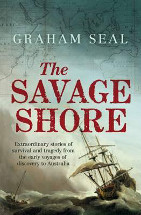The savage shore by Graham Seal

Allen & Unwin, 2015. ISBN 9781760111076
(Age: secondary to adult) Highly recommended. History, Early
exploration of Australia, Spice trade. The role of the VOC (Dutch
East Indies Company) in mapping Australia in the seventeenth century
is vividly brought to life in this highly readable book about the
exploration of Australia. Finding a sea route to the Spice Islands
(East Indies, today's Indonesia) meant huge profits could be made by
this Amsterdam company in bringing spices back to Europe. But they
wanted more: to keep profits up, they needed more resources and more
markets, (doesn't that sound familiar!) and so mariners were told to
watch out for possibilities when they landed on unknown shores. This
resolve coincided with a new faster route being discovered by
Brouwer in 1611. He travelled east from Cape Town, instead of
hugging the African coast, using the Roaring Forties to travel
across the Indian Ocean and turning north to Batavia when the
distance appeared right. Without any accurate means of telling where
they were on the ocean (the discovery of longitude was still a
hundred years away) many ships hit the Western Australian coast,
some disastrously, but took their charts with them to head office
when rescued. So pieces of the Australian coastline were uncovered
and mapped throughout this century but kept close by VOC hesitant to
allow others this information lest they cash in the lucrative trade
that may transpire. Names like Batavia and Tasman spring readily to
mind when thinking about this early exploration, and Seal gives a
full account of both these stories, but includes others less known.
In the eighteenth century, the fortunes of the VOC were in decline
and a more scientific appraisal of the Southland was undertaken by
both the French and British. Stories of Cook, Baudin and Flinders
stand out as they mapped and explored possibilities of the new
country.
I loved reading this history giving a fascinating account of the
attempts to discover the Southland, the activities by the VOC and
the many stories of survival by seamen. Half remembered stories are
fleshed out as the cartographers pieced together the coastline, and
secondary students and adults alike will find this book adds to
their knowledge of our early history. A number of recently published
books add to the interest given by this book, Batavia (Peter
Fitzsimmons, Heinemann, 2011) gives an impressive account of that
chilling chapter in Australia's history as does My father's
islands (Christobel Mattingley, NLA, 2012) giving a fictional
account of Abel Tasman and his importance to Australia's exploration
for younger readers.
I did rankle somewhat at the myth that school children are taught
that Cook discovered Australia, knowing that the texts I read and
used certainly belie this. But a good story always needs a little
spice and this book certainly gives the reader that.
Stories of being marooned on this uninviting land, of murder and
betrayal, of incredible courage and fortitude, of Aboriginal stories
about contact held my attention. A comprehensive index, glossary and
bibliography serve the book and its readers well.
This is a substantial addition to any school, class or home library.
And a marvellous companion to the recent exhibition at the Art
Gallery of South Australia: Treasure Ships, art in the age of
spices.
Fran Knight